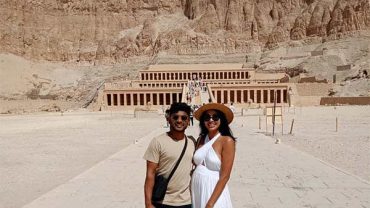Nestled on the eastern bank of the Nile River in Luxor, Egypt, the Karnak Temples Complex stands as a testament to the grandeur of ancient Egyptian civilization. Spanning over 200 acres, this awe-inspiring complex is a treasure trove of archaeological wonders, drawing visitors from around the globe. The journey through Karnak is a step back in time, unveiling the architectural prowess and religious significance that defined the New Kingdom period.
Historical Significance
Delving into the historical tapestry of Karnak, one encounters a living chronicle of the New Kingdom’s spiritual and political life. The complex is a vast open-air museum, comprising multiple temples, chapels, and other structures built over centuries. Among these, the Great Temple of Amun, the central deity of Karnak, is a colossal masterpiece. Constructed over several generations, it reflects the contributions of Pharaohs like Hatshepsut, Thutmose III, and Ramses II. The Avenue of Sphinxes, an imposing processional route connecting Karnak with Luxor Temple, further underscores the religious and symbolic importance of this sacred site. The meticulous hieroglyphic inscriptions on the temple walls narrate the triumphs and tribulations of ancient Egypt, offering a captivating glimpse into the civilization’s cultural and political evolution.
Architectural Marvels
Karnak’s architectural splendors are a marvel of precision and engineering prowess. The Hypostyle Hall, an iconic feature of the complex, boasts towering columns adorned with intricate hieroglyphs and colossal statues of pharaohs. The meticulous alignment of these structures not only served religious functions but also showcased the mastery of ancient Egyptian builders. The Obelisks, particularly the one erected by Queen Hatshepsut, stand as stoic sentinels, piercing the sky with a timeless elegance. Each architectural element within Karnak tells a story – a narrative etched in stone, transcending millennia.
Religious Practices
At the heart of Karnak’s significance lies its role as a religious sanctuary. The temples were dedicated to the Theban triad – Amun, Mut, and Khonsu. Pilgrims and priests alike participated in elaborate rituals, from processions along the Sacred Lake to ceremonies in the sanctuaries. The sound and light shows held at Karnak today attempt to recreate the mystical ambiance that once enveloped this sacred space. Visitors can almost sense the energy of the ancient rituals, forging a connection with the spiritual practices that once echoed through the massive stone walls.
Modern-Day Exploration
While Karnak stands as a timeless relic of the past, it continues to captivate the modern-day traveler. The site’s ongoing excavation and restoration efforts ensure that its glory endures, providing an immersive experience for enthusiasts and scholars alike. A visit to Karnak is not merely a tour through ancient ruins but a journey into the soul of Egypt’s rich cultural heritage. As the sun sets, casting a warm glow on the sandstone structures, one cannot help but feel a profound connection to the ancient civilizations that shaped the course of human history. Karnak Temples Complex is not just a destination; it is a living legacy, inviting all who tread its hallowed grounds to partake in the unfolding story of Egypt’s majestic past.
Artistic Splendors
Beyond its architectural prowess, Karnak Temples Complex is a canvas adorned with artistic marvels. The intricate carvings and vibrant frescoes that embellish the temples depict not only religious scenes but also offer a glimpse into the daily life, mythology, and royal events of ancient Egypt. The colors, though faded by time, still hint at the vibrancy that once graced these sacred walls. The Open-Air Museum within the complex houses a myriad of statues, obelisks, and artifacts, providing a comprehensive view of the artistic achievements of the New Kingdom. Each piece is a testament to the skilled craftsmanship that flourished during this remarkable era.
Sacred Lake and Symbolism
Central to Karnak’s religious practices is the Sacred Lake, a colossal artificial reservoir reflecting the celestial significance of water in ancient Egyptian cosmology. Encircled by columns and statues, this pristine body of water served both practical and symbolic purposes. Priests purified themselves before rituals, and the lake represented the primordial waters from which life emerged in Egyptian creation myths. The symbolism extends to the alignment of key structures with celestial bodies, highlighting the Egyptians’ deep connection with the cosmos and their belief in the divine order that governed their existence.
Visitor Experience
For the modern-day visitor, Karnak offers an immersive and educational experience. The well-preserved state of many structures and the informative signage provide a comprehensive understanding of the site’s historical and cultural significance. A stroll through the complex allows one to appreciate the scale and grandeur of ancient Egyptian architecture. Additionally, multimedia presentations and guided tours enhance the visitor’s comprehension, ensuring that the story of Karnak is accessible to people of all ages and backgrounds. The on-site museum further enriches the experience, displaying artifacts unearthed during excavations and offering a deeper insight into the daily lives of those who contributed to Karnak’s magnificence.
Preservation Efforts and Future Prospects
Preserving Karnak for future generations is a shared responsibility. Ongoing conservation efforts, supported by international organizations and Egyptian authorities, aim to safeguard this invaluable heritage. The use of advanced technologies, such as 3D scanning and virtual reconstructions, ensures that the delicate balance between preservation and accessibility is maintained. As Karnak continues to unveil its secrets, the future holds the promise of new discoveries, further enriching our understanding of ancient Egyptian civilization.




Comment (0)